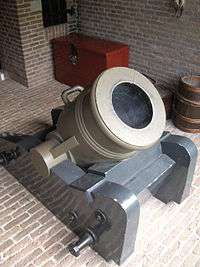Netherlands Fortress Museum
The Netherlands Fortress Museum (Nederlands Vestingmuseum) is located in the city of Naarden, in The Netherlands. The Museum was established in 1955 in the Turfpoort Bastion, one of the six bastions that give the walled city its distinctive star shape. (During World War II, allied bombers returning to Great Britain from bombing missions used it as a marker.) The fortifications themselves, including the bastions, date to the period 1675-1685.
The museum comprises several exhibits, including ones on fortification, garrison life, the Dutch Water Line, and the history of the city of Naarden. These are five metres underground in casemates; because they are underground, temperatures are relatively stable and the quarters are warm in winter and cool in summer. Above ground, the museum also contains a number of guns from the 19th Century.
Tourist information
The fort is open from 10:30 to 17:00 daily Tuesday through Friday, and 12:30 to 17:00 on Sunday, between 16 March and 31 October. Between 1 November and 15 March, the museum is only open on Sundays between 12:00 and 17:00, except that summer hours apply between the Sunday before Christmas and the first Sunday in the New Year. The museum is open on all public holidays except Christmas Day, New Year's Eve, and New Years Day.
There is a snack and souvenir shop in the old cannon depot within the bastion. There are also toilet facilities at the snack shop and near the old entrance to the bastion.
A museum boat that conducts tours of the city moat. The boat leaves from a jetty by the water postern.
Design
The bastion has an arrow-head shape with five points. The walls consist of two meters of layers of brick. Casemates built into the city walls near the narrow base of the arrow head contained guns that permitted the defenders to fire along the main moat. In the area by the lower right hand flank of the bastion there is a gunpowder testing pole, which gunners in the 17th and 18th Centuries used to test the quality of the gunpowder they received.

To the right side of the bastion there is a water postern. Next to it is the bastion's power room. Near the tip of the bastion there is a mortar casemate with quarters for the crews, and a replica 29 cm mortar.
External links
Coordinates: 52°17′36″N 5°9′36″E / 52.29333°N 5.16000°E